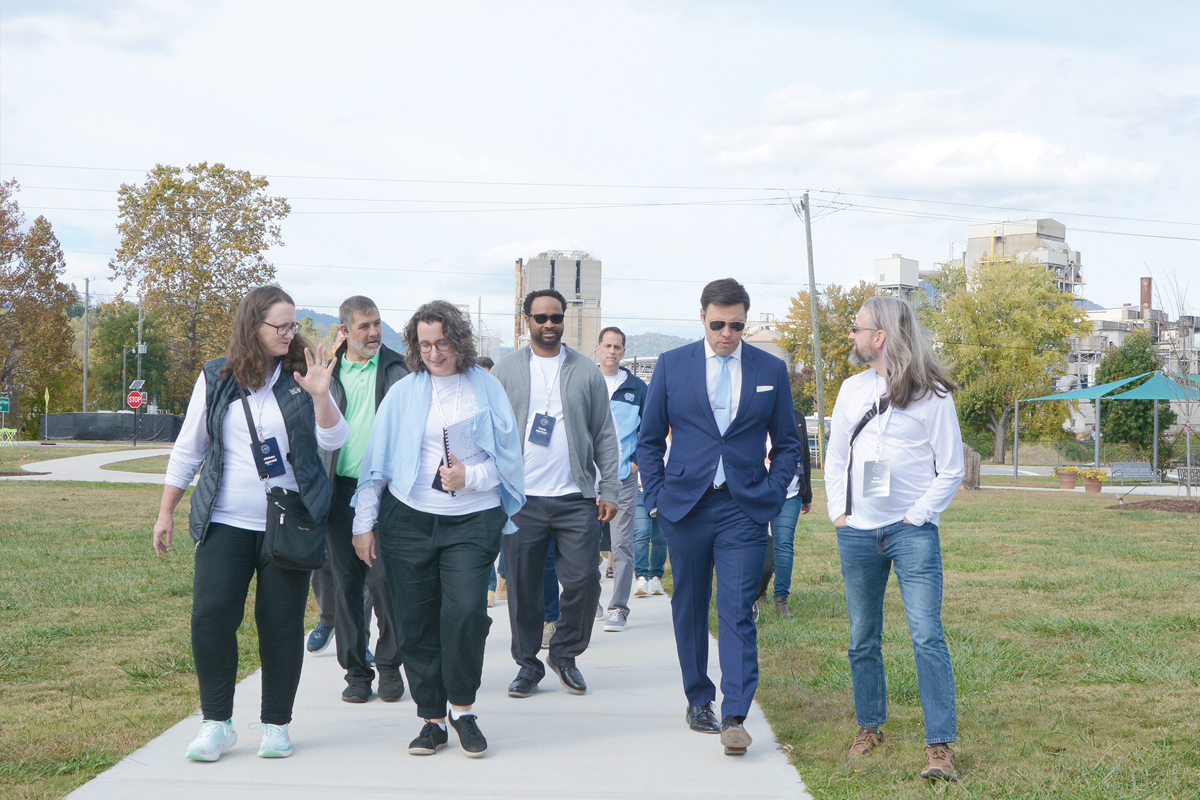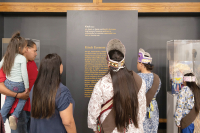Research to test for contamination near Canton mill property
 Canton Mayor Zeb Smathers leads University of North Carolina Chapel Hill faculty and administrators on a tour of Canton Oct. 19. Holly Kays photo
Canton Mayor Zeb Smathers leads University of North Carolina Chapel Hill faculty and administrators on a tour of Canton Oct. 19. Holly Kays photo
A research project aiming to understand contamination levels outside the fence line of the now-shuttered Canton paper mill is likely to draw more than a quarter-million dollars in state funding to test soil, water and air samples nearby.
“Right now, we don’t know what we’re going to find,” said Jeffrey Warren , executive director of the N.C. Collaboratory headquartered at University of North Carolina Chapel Hill. “I think this is like the Forrest Gump box of chocolates — ‘you never know what you’re gonna get.’”
To start, the project plan will likely extend 18-24 months, he said, but the effort may ultimately last longer than that — closer to 36 months. The Collaboratory, which is planning the project in partnership with the N.C. Department of Environmental Quality, anticipates investing something like $250,000 to $500,000 over time.
Charting the future
Warren made the announcement during an Oct. 26 luncheon at The Grateful Table in Canton, attended by more than 40 UNC faculty and administrators amid a three-day tour of the state’s western half. This year’s Tar Heels Bus Tour offered two routes, one heading east and the other west from Chapel Hill, making a combined 21 stops in 19 counties.
Canton Mayor Zeb Smathers, who learned about the project for the first time that day, said he’s hopeful for what the “legitimacy and respect” imbued by DEQ’s involvement combined with the “knowledge and heartfelt leadership” from UNC can do for Canton. He applauded the “very deliberate” decision to choose Canton as one of the western bus’s nine stops.
Related Items
“I was talking about the future of Canton today with an astrophysicist. I mean, that’s the type of passion they have and ideas, and that’s what we want at the table,” Smathers said. “We want as many people and diverse ideas about what is next, with the resources and intelligence they bring to the conversation.”
The town of Canton has faced more than its share of challenges over the past few years. In 2021, a catastrophic flood ripped through downtown, causing extensive damage to homes and buildings — and claiming six lives upstream in Cruso, where the flooding was most severe. Less than two years later, Pactiv Evergreen announced the closure of Canton’s 115-year-old paper mill, leaving roughly 1,000 workers instantly unemployed.
It was a blow to the small town, both economically and culturally. But after operations ceased in June, attention turned to cleaning up the site and sketching out the next chapter of Canton’s story.
“I think all of us know, we do see a future on that mill site,” Smathers said. “And it could be manufacturing and commercial and residential, but we also owe an obligation to learn from the mistakes in our past, to make sure that it is environmentally sound and respectful. We see the [Pigeon] River as a huge economic booster into our future. And so before we start really doing that, we’ve got to make sure it’s safe and sound.”
Past the fence line
Established by the N.C. General Assembly in 2016, the N.C. Collaboratory is given significant discretionary funding and wide latitude to carry out research projects that can then be used to inform legislative action. Warren described it as the research “front porch” of the university system.
After the mill closure was announced, he began talking with DEQ Secretary Elizabeth Biser about how the Collaborative could help.
“She said, ‘The company is going to be focused on the property they own and inside the fence, but what we really need to get a handle on is to understand what’s going on outside — outside of the fence line,’” said Warren.

Jeffrey Warren addresses the Tar Heels Bus Tour group at The Grateful Table in Canton Oct. 19. Holly Kays photo
Testing will look for a wide range of compounds, including components of the toxic papermaking byproduct known as black liquor, within a specified radius of any properties associated with the mill. The team will also likely test for PFAS, a class of chemicals that break down extremely slowly over time and have been found in the blood of people and animals all over the world.
The purpose of the testing is not so much to assign blame for the presence of any contaminants found — often, it’s difficult to prove how a particular chemical came to be present in a sample, and to force a suspected polluter to clean it up — but rather to develop a “to do” list of issues to be addressed.
“We understand that [the mill site] is a cornerstone of economic development and jobs for this area,” Warren said, “so anything we can do to help the state repurpose that site and anything that may come off-site — it’s definitely in benefit for the state, for everybody, to make sure we identify any issues and get them cleaned up.”
Many of the project specifics are yet to be determined, and full funding won’t be available until February, after the Budget Office has certified the newly enacted budget and money starts to flow. In the meantime, Warren said, the Collaboratory will be building its teams and get researchers out in the field to start some sampling, which will initially focus on water — creeks, rivers and wells. More research will follow in the summer. Warren envisions the project as a multi-campus effort, hoping to see Western Carolina University take the lead and Chapel Hill, which may have more sensitive analytical instruments at its disposal, play a supporting role.
Heavy metals found in riverbank soil sample
While the Collaboratory-funded research is expected to offer vital insight into the environmental situation past Pactiv Evergreen’s property lines, assessing the situation within those lines is DEQ’s responsibility.
With more than six months gone since papermaking stopped, the department has yet to complete an environmental assessment of the mill property or a site closure plan. According to Public Information Officer Josh Kastrinsky, that’s because the department is still occupied with sampling and remediation related to ongoing fuel oil and black liquor cleanups, on which it is working in conjunction with the U.S. Environmental Protection Agency.

An Aug. 28 photo shows black liquor deposits in the Pigeon River. EPA photo
“The extent of these ongoing actions will determine next steps for future on-site assessments,” Kastrinsky said.
The fuel oil cleanup stems from issues with a tank or transfer line on the mill property, with oil observed on the Pigeon River in June 2021 and again in August 2022. A 466-page workplan filed June 15 outlines a schedule of sampling and analysis. The workplan called for a technical memo to be submitted this month.
The black liquor cleanup is a more entrenched issue, with the toxic sludge spotted in the river January 2022 associated with an ongoing problem that first received a notice of violation in 1994. Agency staff spotted black liquor deposits on multiple occasions since then.
Notices of violation issued to International Paper and Pactiv Evergreen following the seep’s discovery have spurred various sampling events to understand the extent and impact of the contamination. In June, Pactiv Evergreen consultant Ensafe sampled the Pigeon River near one of the seepage areas.
A preliminary report showed extremely high levels of several heavy metals in one of the sampling sites, a pit dug along the exposed riverbank. Lead levels were 2,796 times higher than the state standard. Copper was 332 times higher, chromium 21 times higher, nickel 17 times higher, zinc five times higher and arsenic nearly four times higher. Beryllium came in more than 30% above the state limit. However, the report said, the “vast majority” of sites and chemicals analyzed came in below detection limits.
The most comprehensive sampling yet took place in September, with a work plan filed in June identifying dozens of chemicals to test for. The results of this sampling will inform development of a remedial action plan to get rid of any remaining groundwater contamination. Public records show that PFAS was later added to the list of contaminants the September sampling screened for. The results won’t be available until November, Kastrinsky said.

After 115 years in operation, After 115 years in operation, the Canton mill stopped making paper in May. Holly Kays photo
While concerns continue about contamination related to these two ongoing cleanups, there is also good news. A DEQ survey of aquatic creatures conducted downstream from the mill site in August yielded the first-ever “good” bioclassification at that site in the 39 years and 17 observations on record, Kastrinsky said. In July, the N.C. Wildlife Resources Commission sampled fish populations at three sites downstream from the mill and found double the diversity and 15 times the number of fish logged during a previous sampling event in May, when the mill was still operating.









